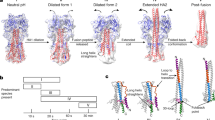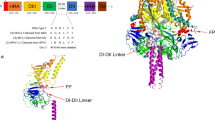Summary
To clarify the role of acidic amino acid residues in the “fusion segment” of hemagglutinin (HA) of influenza A virus (H1N1) in pH-dependent membrane fusion, we have constructed and expressed five mutant HA cDNAs in CV-1 cells by SV40-HA virus vectors (SVHA). Fusion activities of the five mutant HAs were examined by lipid mixing and polykaryon formation assays. In spite of the substitution of Gly and Lys for the acidic residues, all the mutants were found to retain their low-pH-dependent fusion activity by lipid mixing assay. Although SVHA-G19(HA219D → G), −K11 (HA211E → K) and −K19(HA219D → K) induced polykaryon formation at low pH as wild type HA did, SVHA-G11(HA211E → G) induced limited polykaryon formation and SVHA-G11,19 (HA211E → G, 19D → G) did not. The substitution of Gly for Glu at position 11 inhibited widening of the initial fusion pore. However, Lys mutants induced the formation of an initial fusion pore and widened it at low pH where Lys residues might have positive charges. These results suggest that the neutralization of the charges on acidic residues in the “fusion segment” at low pH is not important for interaction of the “fusion segment” with the target lipid bilayer or for triggering the membrane fusion.
Similar content being viewed by others
References
Bullough PA, Hughson FM, Skehel JJ, Wiley DC (1994) Structure of influenza hemagglutinin at the pH of membrane fusion. Nature 371: 37–43
Daniels RS, Downie JC, Hay AJ, Knossow M, Skehel JJ, Wang ML, Wiley DC (1985) Fusion mutants of the influenza virus hemagglutinin glycoprotein. Cell 40: 431–439
Eidelman O, Cabantchik ZI (1980) A method for measuring anion transfer across red cell membranes by continuous monitoring of fluorescence. Anal Biochem 106: 335–341
Gething M-J, Doms RW, York D, White J (1986) Studies on the mechanism of membrane fusion: site-specific mutagenesis of the hemagglutinin of influenza virus. J Cell Biol 102: 11–23
Godley L, Pfeifer J, Steinhauer D, Ely B, Shaw G, Kaufmann R, Suchanek E, Pabo C, Skehel JJ, Wiley DC, Wharton S (1992) Introduction of intersubunit disulfide bonds in the membrane-distal region of the influenza hemagglutinin abolishes membrane fusion activity. Cell 68: 635–645
Kawaoka Y, Yamunicova S, Chambers TM, Lvov DK, Webster RG (1990) Molecular characterization of a new hemagglutinin, subtype H14 of influenza A virus. Virology 179: 759–767
Kemble GW, Bodian DL, Rose J, Wilson JA, White JM (1992) Intermonomer disulfide bonds impair the fusion activity of influenza virus hemagglutinin. J Virol 66: 4940–4950
Klenk H-D, Rott R, Orlich M, Blodorn J (1975) Enhancement of the infectivity of influenza A viruses by trypsin treatment. Virology 68: 426–439
Maeda T, Kawasaki K, Ohnishi S (1981) Interaction of influenza virus hemagglutinin with target membrane lipids is a key step in virus-induced hemolyses and fusion at pH=5.2. Proc Natl Acad Sci USA 78: 4133–4137
Morris SJ, Sarkar DP, White JM, Blumenthal R (1989) Kinetics of pH-dependent fusion between 3T3 fibroblasts expressing influenza hemagglutinin and red blood cells. J Biol Chem 264: 3972–3978
Murata M, Sugahara Y, Takahashi S, Ohnishi S (1987) pH-dependent membrane fusion activity of a synthetic twenty amino acid peptide with the same sequence as that of the hydrophobic segment of influenza virus hemagglutinin. J Biochem 102: 957–962
Murata M, Takahashi S, Kagiwada S, Suzuki A, Ohnishi S (1992) pH-dependent membrane fusion and vesiculation of phospholipid large unilamellar vesicles induced by amphiphilic anionic and cationic peptides. Biochemistry 31: 1986–1992
Nobusawa E, Nakajima K, Nakajima S (1985) Expression of hemagglutinin gene. Vaccine 3: 172–174
Nobusawa E, Nakajima K (1988) Amino acid substitution at 226 of the hemagglutinin molecule of influenza (H1N1) virus affects receptor binding activity but not fusion activity. Virology 167: 8–14
Nobusawa E, Aoyama T, Kato H, Suzuki Y, Tateno Y, Nakajima K (1991) Comparison of complete amino acid sequences and receptor-binding properties among 13 serotypes of hemagglutinin of influenza A viruses. Virology 182: 475–485
Sarkar DP, Morris SJ, Eidelman O, Zimmerberg J, Blumenthal R (1989) Initial stages of influenza hemagglutinin-induced cell fusion monitored simultaneously by two fluorescent events: cytoplasmic continuity and lipid mixing. J Cell Biol 109: 113–122
Schoch C, Blumenthal R (1993) Role of the fusion peptide sequence in initial stages of influenza hemagglutinin-induced cell fusion. J Biol Chem 268: 9267–9274
Spruce AE, Uwata A, White JM, Almers W (1989) Patch clamp studies of single cell-fusion events mediated by a viral fusion protein. Nature 342: 555–558
Stegmann T, White JM, Helenius A (1990) Intermediates in influenza induced membrane fusion. EMBO J 9: 4231–4241
Weis WI, Cusack SC, Brown JH, Daniels RS, Skehel JJ, Wiley DC (1990) The structure of a membrane fusion mutant of the influenza virus hemagglutinin. EMBO J 9: 17–24
White JM, Helenius A, Gething M-J (1982) Hemagglutinin of influenza virus expressed from a cloned gene promotes membrane fusion. Nature 300: 658–659
White JM, Wilson IA (1987) Anti-peptide antibodies detect steps in a protein conformational change: low-pH activation of the influenza virus hemagglutinin. J Cell Biol 105: 2887–2896
Wiley DC, Skehel JJ (1987) The structure and function of the hemagglutinin membrane glycoprotein of influenza virus. Annu Rev Biochem 56: 365–394
Wilson IA, Skehel JJ, Wiley DC (1981) Structure of the hemagglutinin membrane glycoprotein of influenza virus at 3 Å resolution. Nature 289: 366–375
Wunderli-Allenspach H, Ott S (1990) Kinetics of fusion and lipid transfer between virus receptor containing liposomes and influenza viruses as measured with the octadecylrhodamine B chloride assay. Biochemistry 29: 1990–1997
Author information
Authors and Affiliations
Rights and permissions
About this article
Cite this article
Nobusawa, E., Hishida, R., Murata, M. et al. The role of acidic residues in the “fusion segment” of influenza A virus hemagglutinin in low-pH-dependent membrane fusion. Archives of Virology 140, 865–875 (1995). https://doi.org/10.1007/BF01314963
Received:
Accepted:
Issue Date:
DOI: https://doi.org/10.1007/BF01314963




